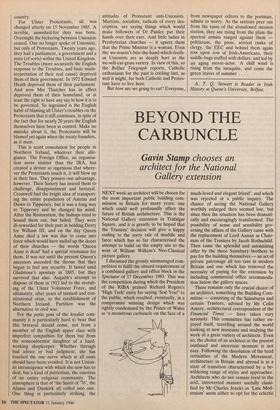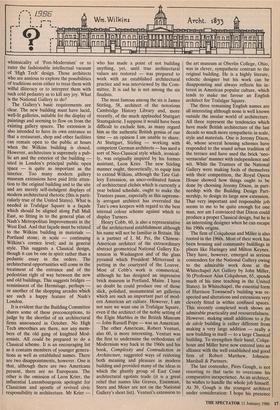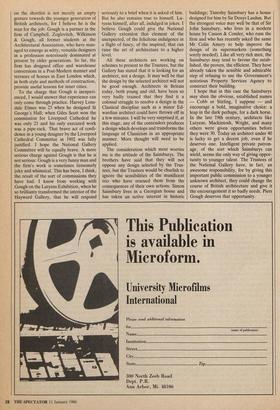BEYOND THE CARBUNCLE
Gavin Stamp chooses an
architect for the National Gallery extension
NEXT week an architect will be chosen for the most important public building com- mission in Britain for many years: one which could well profoundly affect the future of British architecture. This is the National Gallery extension in Trafalgar Square, and it is greatly to be hoped that the Trustees' decision will give a happy ending to the sorry tale of muddle and farce which has so far characterised the attempt to build on the empty site to the west of William Wilkins's Neo-Classical picture gallery.
I discussed the grossly mismanaged com- petition to fulfil the absurd requirement of a combined gallery and office block in the Spectator of 17 December 1983. This was the competition during which the President of the RIBA praised Richard Rogers's `High Tech' entry for saying 'Sod You!' to the public, which resulted, eventually, in a compromise winning design which was rightly condemned by the Prince of Wales as 'a monstrous carbuncle on the face of a much-loved and elegant friend', and which was rejected at a public inquiry. The chance of seeing the National Gallery worthily enlarged then seemed lost, but since then the situation has been dramati- cally and encouragingly transformed. The possibility of sense and sensibility gov- erning the affairs of the Gallery came with the replacement of Lord Annan as Chair- man of the Trustees by Jacob Rothschild. Then came the splendid and astonishing offer by the three Sainsbury brothers to pay for the building themselves — an act of private patronage all too rare in modern Britain and one which has removed the necessity of paying for the extension by including commercial office accommoda- tion below the gallery spaces.
There remains only the crucial choice of an architect, something the Building Com- mittee — consisting of the Sainsburys and certain Trustees, advised by Mr Colin Amery, architectural correspondent of the Financial Times — have taken very seriously. This committee has rather en- joyed itself, travelling around the world looking at new museums and studying the work of a great variety of architects. Even so, the choice of an architect at the present confused and uncertain moment is not easy. Following the dissolution of the hard certainties of the Modern Movement, architecture in Britain and abroad is in a state of transition characterised by a be- wildering range of styles and approaches. Architects who do not remain loyal to the arid, introverted manner usefully classi- fied by Mr Charles Jencks as 'Late Mod- ernism' seem either to opt for the eclectic whimsicality of Post-Modernism' or to enter the fashionable intellectual vacuum of 'High Tech' design. Those architects who are anxious to explore the possibilities of traditions seem either to treat them with wilful illiteracy or to interpret them with such cold pedantry as to kill any joy. What is the National Gallery to do?
The Gallery's basic requirements are clear. The new building must have lucid, well-lit galleries, suitable for the display of paintings and seeming to flow on from the existing gallery spaces. The extension is also intended to have its own entrance so that a restaurant, shop and other facilities can remain open to the public at hours when the Wilkins building is closed. However, architecture is supremely a pub- lic art and the exterior of the building sited in London's principal public open space — is quite as important as the interior. Too many modern gallery museum extensions have paid little atten- tion to the original building and to the site and are merely self-indulgent displays of modern architectural rhetoric (this is parti- cularly true of the United States). What is needed in Trafalgar Square is a façade which should be aligned along Pall Mall East, so fitting in to the general plan of Nash's Metropolitan Improvements in the West End. And that façade must be related to the Wilkins building in materials Portland stone; in scale — continuing Wilkins's cornice level; and in general style. This suggests a Classical design, though it can be one in spirit rather than a pedantic essay in the orders. The architectural opportunities will come in the treatment of the entrance and of the pedestrian right of way between the new and old buildings. This suggests bridges reminiscent of the Hermitage, perhaps or another of the shopping arcades which are such a happy feature of Nash's London.
It is evident that the Building Committee shares some of these preconceptions, to judge by the shortlist of six architectural firms announced in October. No High Tech smoothies are there, nor any mem- bers of the old gang of knighted Mod- ernists. All could be prepared to do a Classical scheme. It is an encouraging list as it contains members of younger genera- tions as well as established names. There are two disappointments, however. One is that, although there are two Americans present, there are no Europeans. The other is the omission of Leon Krier, the influential Luxembourgeois apologist for Classicism and apostle of revived civic responsibility in architecture. Mr Krier — who has made a point of not building anything, yet, until true architectural values are restored — was prepared to work with an established architectural practice and was interviewed by the Com- mittee. It is sad he is not among the six finalists.
The most famous among the six is James Stirling, 58, architect of the notorious Cambridge History Library and, more recently, of the much applauded Stuttgart Staatsgalerie. I suppose it would have been difficult to exclude him, as many regard him as the authentic British genius of our time — an opinion I am unable to share. At Stuttgart, Stirling — working with competent German architects — has used a sort of Neo-Classical style which, ironical- ly, was originally inspired by his former assistant, Leon Krier. The new Stirling manner ought, theoretically, to equip him to extend Wilkins, although the Tate Gal- lery Extension, an unco-ordinated fusion of architectural clichés which is currently a year behind schedule, ought to make the Trustees pause, especially as this supreme- ly arrogant architect has overruled the Tate's own keepers with regard to the best internal colour scheme against which to display Turners.
Henry Cobb, 60, is also a representative of the architectural establishment although his name will not be familiar in Britain. He is a partner of I. M. Pei, the Chinese- American architect of the extraordinary abstract geometrical National Gallery Ex- tension in Washington and of the glass pyramid which President Mitterrand is putting in the courtyard of the Louvre. Most of Cobb's work is commerical, although he has designed an impressive brick museum in Portland, Maine. I have no doubt he could produce one of those slick, polished, monumental art galleries which are such an important part of mod- ern American art culture. However, I am not sure we want one in Trafalgar Square, even if the architect of the noble setting of the Elgin Marbles in the British Museum — John Russell Pope — was an American.
The other American, Robert Venturi, also 60, is more interesting. Venturi was the first to undermine the orthodoxies of Modernism way back in the 1960s and his book, Complexity and Contradiction in Architecture, suggested ways of restoring both meaning and pleasure in modern building and provided many of the ideas in which the ghastly group of East Coast architectural egotists trade (it is a great relief that names like Graves, Eisenman, Stern and Meier are not on the National Gallery's short list). Venturi's extension to the art museum at Oberlin College, Ohio, was in clever, sympathetic contrast to the original building. He is a highly literate, eclectic designer but his work can be disappointing and always reflects his in- terest in American popular culture, which tends to make me favour an English architect for Trafalgar Square.
The three remaining English names are all interesting although none is well known outside the insular world of architecture. All three represent the tendencies which have made British architecture of the last decade so much more sympathetic in scale, style and materials. One is Jeremy Dixon, 46, whose several housing schemes have responded to the sound urban tradition of the terrace and have used the brick 'neo- vernacular' manner with independence and wit. While the Trustees of the National Gallery were making fools of themselves with their competition, the Royal Opera House showed how things ought to be done by choosing Jeremy Dixon, in part- nership with the Building Design Part- nership, to design its large new extension.
That very important and responsible job seems to me to be quite enough for one man, nor am I convinced that Dixon could produce a proper Classical design, but he is an interesting designer when he can escape his 1960s origins.
The firm of Colquhoun and Miller is also rooted in the 1960s. Most of their work has been housing and community buildings in places like Haringey and Milton Keynes. They have, however, emerged as serious contenders for the National Gallery owing to the admirable work done at the Whitechapel Art Gallery by John Miller, 56 (Professor Alan Colquhoun, 65, spends much of his time teaching in the United States). In Whitechapel, the essential form of Harrison Townsend's building was re- spected and alterations and extensions very cleverly fitted in within confined spaces.
This recently completed work shows an admirable practicality and resourcefulness. However, making small additions to a fin de siecle building is rather different from making a very large addition — really a new building in itself — to a large Classical building. To strengthen their hand, Colqu- houn and Miller have now entered into an alliance with the well established and good firm of Robert Matthew, Johnson- Marshall & Partners.
The last contender, Piers Gough, is not resorting to that tactic to overcome his comparative inexperience. As an architect, he wishes to handle the whole job himself. At 39, Gough is the youngest architect under consideration: I hope his presence on the shortlist is not merely an empty gesture towards the younger generation of British architects, for I believe he is the man for the job. Gough is a partner in the firm of Campbell, Zoglovitch, Wilkinson & Gough, all former students at the Architectural Association, who have man- aged to emerge as witty, versatile designers in a profession notoriously dominated at present by older generations. So far, the firm has designed office and warehouse conversions in a Post-Modern manner and terraces of houses in East London which, in both style and methods of construction, provide useful lessons for inner cities.
To the charge that Gough is inexperi- enced, I would answer that experience can only come through practice. Harvey Lons- dale Elmes was 25 when he designed St George's Hall; when Giles Scott won the commission for Liverpool Cathedral he was only 21 and his only executed work was a pipe-rack. That brave act of confi- dence in a young designer by the Liverpool Cathedral Committee in 1902 was fully justified. I hope the National Gallery Committee will be equally brave. A more serious charge against Gough is that he is not serious: Gough is a very funny man and the firm's work is sometimes tiresomely joky and whimsical. This has been, I think, the result of the sort of commissions they have had. I know from working with Gough on the Lutyens Exhibition, when he so brillianty transformed the interior of the Hayward Gallery, that he will respond seriously to a brief when it is asked of him. But he also remains true to himself. Lu- tyens himself, after all, indulged in jokes. I believe Gough could give the National Gallery extension that element of the unexpected, of the felicitous indulgence in a flight of fancy, of the inspired, that can raise the art of architecture to a higher level.
All these architects are working on schemes to present to the Trustees, but the Gallery has stated that it is looking for an architect, not a design. It may well be that the design by the selected architect will not be good enough. Architects in Britain today, both young and old, have been so very badly trained that they find it a colossal struggle to resolve a design in the Classical discipline such as a minor Ed- wardian architect could have thrown off in a few minutes. I will be very surprised if, at this stage, any of the contenders produces a design which develops and transforms the language of Classicism in an appropriate manner. More thought will need to be applied.
The consideration which most worries me is the attitude of the Sainsburys. The brothers have said that they will not oppose any design selected by the Trus- tees, but the Trustees would be churlish to ignore the sensibilities of the munificent trio who have rescued them from the consequences of their own actions. Simon Sainsbury lives in a Georgian house and has taken an active interest in historic buildings; Timothy Sainsbury has a house designed for him by Sir Denys Lasdun. But the strongest voice may well be that of Sir John Sainsbury, who lives in a modern house by Casson & Conder, who runs the firm and who has recently asked the same Mr Colin Amery to help improve the design of its supermarkets (something sorely needed). Like all very rich men, the Sainsburys may tend to favour the estab- lished, the proven, the efficient. They have already taken the sensible and admirable step of refusing to use the Government's notorious Property Services Agency to construct their building.
I hope that in this case the Sainsburys may shun the obvious, established names — Cobb or Stirling, I suppose — and encourage a bold, imaginative choice: a leap in the dark perhaps, for a dark horse. In the late 19th century, architects like Lutyens, Mackintosh, Wright, and many others were given opportunities before they were 30. Today an architect under 40 is lucky to get a decent job, even if he deserves one. Intelligent private patron- age, of the sort which Sainsburys can wield, seems the only way of giving oppor- tunity to younger talent. The Trustees of the National Gallery have, in fact, an awesome responsibility, for by giving this important public commission to a younger unknown architect, they could change the course of British architecture and give it the encouragement it so badly needs. Piers Gough deserves that opportunity.




























































 Previous page
Previous page